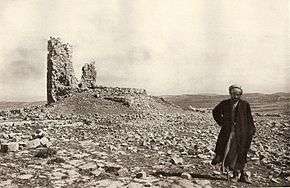Beth-zur
 Ruins of medieval tower at Khirbet Burj as-Sur, biblical Beth-zur, 1920s | |
 Shown within the West Bank | |
| Location | West Bank |
|---|---|
| Coordinates | 31°35′00″N 35°06′00″E / 31.58333°N 35.1°E |
| Site notes | |
| Archaeologists | O.R. Sellers[1] |
Beth-Zur (also Beit Tzur, Bethsura) is a biblical site of historic and archaeological importance in the mountains of Hebron in southern Judea, now part of the West Bank. Beth Zur is mentioned several times in the Hebrew Bible and the writings of the Roman Jewish historian Josephus. The Battle of Beth-Zur took place here in 164 BCE.[2]
Beth-Zur has been identified with the site of Khirbet et-Tubeiqa.[3]
Name
The name Beth-Zur means "house of rock", or less likely "house of the god Zur".
Location and biblical mention
Beth-Zur is mentioned in Joshua as being near Halhul and Gedor, in the Judean hill country.[4] Rehoboam is credited with its fortification.[5] The Prophet Nehemiah is said to have been the ruler of a half district of the same name.[6]
Bronze Age to Persian period
O.R. Sellers, excavating at Khirbet et-Tubeiqa in 1957, discovered that the site was first settled at the end of the third millennium BCE, and was fortified, like many other Canaanite cities, during the Middle Bronze Age IIB in the 18th-17th centuries BCE.[1] The settlement continued into the Iron Age, and a rare coin inscribed "the governor Hezekiah" attests to the existence of Beth-Zur during the Persian period.[1]
Hellenistic period
Betsoura, as the Greeks called the town, reached a peak of prosperity during the Hellenistic period.[1] A citadel was built at Betsoura during the 3rd century BCE,[1] when a series of wars between the Seleucid Empire and the Ptolemaic Kingdom of Egypt rocked the region.
In 164 BC, during the Maccabean wars, the Battle of Beth-Zur was fought here.[2] The site’s importance lay in its strategic location on a hilltop dominating the highway, preventing the approach of a hostile army from the Valley of Elah to the Judean plateau. Josephus describes Beth-Zur as the mightiest stronghold in Judea.[7]
The battle was the confrontation between the Seleucid Greek general Lysias and the Maccabees, led by Judas Maccabeus, resulting in the defeat of Lysias and his forces. This victory was followed by the recapture of Jerusalem by the Maccabees. The key to the battle was the exploitation of the natural terrain and fortifications.
Once victorious, Judas rebuilt the old Middle Bronze Age ramparts and the more recent citadel. The fortified town then changed hands repeatedly until regaining the peaceful character lost during the Maccabean Wars, under the reign of John Hyrcanus (r. 134-104). However, by 100 BCE the town had been fully abandoned.[1]
Byzantine period
Beth-Zur was inhabited in the lifetimes of Eusebius (260/265–339/340), who mentions it as the village of Bethsoro (Onomasticon 52:2),[1] and of Jerome.
Crusader period
Khirbet Burj as-Sur, the medieval site at Beth-Zur, has the Palestine grid coordinates 1594.1104.[8] The ruins of a tower stand near the main road between Jerusalem and Hebron, approximately 4 miles north of Hebron. The western wall, the most visible remnant of the building, is standing to a height of 9.5 m.[8] Beithsur or Bethsura, as the Crusaders called Beth-Zur, was given in 1136 to the Hospitallers by the lord of Hebron.[8]
References
- 1 2 3 4 5 6 7 Avraham Negev and Shimon Gibson (2001). Achzib Beth Zur; Bethsura. Archaeological Encyclopedia of the Holy Land. New York and London: Continuum. pp. 89–90. ISBN 0-8264-1316-1.
- 1 2 1 Macc. 4:29,61; 6:7,26,31,49,50; 9:52; 10:14; 11:65; 14:7,33
- ↑ Erich Zenger, Einleitung in das Alte Testament, p. 721
- ↑ Joshua 15:58
- ↑ 2 Chronicles 11:7
- ↑ Nehemiah 3:16
- ↑ Ant., XIII, v, 6
- 1 2 3 Denys Pringle (2009). Burj as-Sur (No. 71). Secular Buildings in the Crusader Kingdom of Jerusalem: An Archaeological Gazetteer. Cambridge University Press. pp. 41–42. ISBN 9780521102636. Retrieved 11 May 2015.
Bibliography
- Masterman, E. W. G. (1915). "Beth-Zur". International Standard Bible Encyclopedia. Eds. Orr, James, M.A., D.D. Retrieved December 9, 2005.
- Hutchinson, J. (1915). "Lysias". International Standard Bible Encyclopedia. Eds. Orr, James, M.A., D.D. Retrieved December 12, 2007.